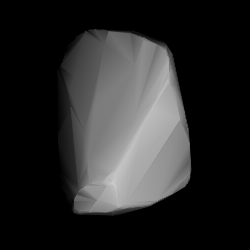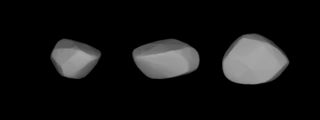Related Research Articles
515 Athalia, provisional designation 1903 ME, is a carbonaceous Themistian asteroid from the outer regions of the asteroid belt, approximately 40 kilometers in diameter. It was discovered on 20 September 1903, by German astronomer Max Wolf at the Heidelberg Observatory in southwest Germany. The asteroid was named after the ancient Judahite queen Athaliah.

1322 Coppernicus, provisional designation 1934 LA, is a stony background asteroid from the inner regions of the asteroid belt, approximately 10 kilometers in diameter. Discovered by Karl Reinmuth at Heidelberg Observatory in 1934, the asteroid was later named after Polish astronomer Nicolaus Copernicus.
La Paz, provisional designation 1923 PD, is a carbonaceous asteroid from the outer region of the asteroid belt, approximately 40 kilometers in diameter. It was discovered on 31 October 1923, by German astronomer Max Wolf at the Heidelberg-Königstuhl State Observatory and named after the city La Paz in Bolivia.
1026 Ingrid, provisional designation 1923 NY, is a stony Florian asteroid and long-lost minor planet (1923–1986) from the inner regions of the asteroid belt, approximately 7 kilometers in diameter. It was discovered by Karl Reinmuth at Heidelberg in 1923, and later named after Ingrid, niece and godchild of astronomer Albrecht Kahrstedt.

1030 Vitja, provisional designation 1924 RQ, is a dark background asteroid from the outer regions of the asteroid belt, approximately 60 kilometers in diameter. It was discovered on 25 May 1924, by Soviet–Russian astronomer Vladimir Albitsky at the Simeiz Observatory on the Crimean peninsula. The asteroid was named in honor of Viktor Zaslavskij (1925–1944), a relative of the discoverer.

1050 Meta, provisional designation 1925 RC, is a stony Eunomia asteroid from the central regions of the asteroid belt, approximately 10 kilometers in diameter. It was discovered on 14 September 1925, by German astronomer Karl Reinmuth at the Heidelberg Observatory in southwest Germany. The meaning of the asteroids's name is unknown. The presumably S-type asteroid has a rotation period of 6.14 hours and possibly an elongated shape.
1070 Tunica, provisional designation 1926 RB, is a dark background asteroid from the outer regions of the asteroid belt, approximately 35 kilometers in diameter. It was discovered on 1 September 1926, by German astronomer Karl Reinmuth at the Heidelberg-Königstuhl State Observatory in southwest Germany. The asteroid was named after Petrorhagia, a flowering plant also known as "Tunica".
1074 Beljawskya, provisional designation 1925 BE, is a Themistian asteroid from the outer region of the asteroid belt, approximately 48 kilometers in diameter.
1124 Stroobantia, provisional designation 1928 TB, is a metallic asteroid from the outer region of the asteroid belt, approximately 25 kilometers in diameter. It was discovered on 6 October 1928, by Belgian astronomer Eugène Delporte at Uccle Observatory in Belgium. It is named for astronomer Paul Stroobant.

1132 Hollandia, provisional designation 1929 RB1, is a stony asteroid from the middle region of the asteroid belt, approximately 27 kilometers in diameter. It was discovered on 13 September 1929, by Dutch astronomer Hendrik van Gent at Leiden Southern Station, annex to the Johannesburg Observatory in South Africa. It was named for the region Holland in the Netherlands.
4899 Candace, provisional designation 1988 JU, is a background asteroid from the inner regions of the asteroid belt, approximately 7 kilometers in diameter. It was discovered on 9 May 1988, by astronomer couple Carolyn and Eugene Shoemaker at the Palomar Observatory in California, United States. The asteroid was named after American chemist Candace Kohl.
1581 Abanderada, provisional designation 1950 LA1, is a dark Themistian asteroid from the outer regions of the asteroid belt, approximately 35 kilometers in diameter. It was discovered on 15 June 1950, by Argentine astronomer Miguel Itzigsohn at the La Plata Astronomical Observatory in La Plata, Argentina. The asteroid was named after Eva Perón.
1712 Angola, provisional designation 1935 KC, is a dark asteroid from the outer regions of the asteroid belt, approximately 66 kilometers in diameter. It was discovered on 28 May 1935, by English-born South African astronomer Cyril Jackson at Johannesburg Observatory in South Africa. It is named after the Republic of Angola.

1551 Argelander, provisional designation 1938 DC1, is a background asteroid from the inner regions of the asteroid belt, approximately 10 kilometers (6.2 miles) in diameter. It was discovered on 24 February 1938, by Finnish astronomer Yrjö Väisälä at the Turku Observatory in southwest Finland. The likely S-type asteroid has a rotation period of 4.1 hours. It was named after German astronomer Friedrich Argelander.
1304 Arosa, provisional designation 1928 KC, is a metallic asteroid from the outer region of the asteroid belt, approximately 40 kilometers in diameter. It was discovered on 21 May 1928, by German astronomer Karl Reinmuth at Heidelberg Observatory in southwest Germany. It was named after the Swiss mountain village of Arosa.

1241 Dysona, provisional designation 1932 EB1, is a dark background asteroid from the outer regions of the asteroid belt, approximately 77 kilometers in diameter. It was discovered on 4 March 1932, by English astronomer Harry Edwin Wood at the Union Observatory in Johannesburg, South Africa. The asteroid was named after English astronomer Frank Watson Dyson.
1199 Geldonia is an Eoan asteroid from the outer regions of the asteroid belt, approximately 32 kilometers in diameter. It was discovered on 14 September 1931, by Belgian astronomer Eugène Delporte at the Royal Observatory of Belgium in Uccle. The asteroid was named after the Belgian town of Jodoigne.
2013 Tucapel, provisional designation 1971 UH4, is an eccentric Florian asteroid from the inner regions of the asteroid belt, approximately 11 kilometers in diameter. It was discovered on 22 October 1971, by the University of Chile's National Astronomical Observatory at Cerro El Roble Astronomical Station. It was named for one of the indigenous Mapuche chiefs.
1296 Andrée, provisional designation 1933 WE, is a stony Nysian asteroid from the inner regions of the asteroid belt, approximately 25 kilometers in diameter. It was discovered on 25 November 1933, by French astronomer Louis Boyer at the North African Algiers Observatory, Algeria, and named after the discoverer's niece.
1466 Mündleria, provisional designation 1938 KA, is a carbonaceous asteroid from the inner regions of the asteroid belt, approximately 22 kilometers in diameter.
References
- 1 2 3 4 "JPL Small-Body Database Browser: 1790 Volkov (1967 ER)" (2017-05-06 last obs.). Jet Propulsion Laboratory . Retrieved 8 June 2017.
- 1 2 3 Schmadel, Lutz D. (2007). "(1790) Volkov". Dictionary of Minor Planet Names – (1790) Volkov. Springer Berlin Heidelberg. p. 143. doi:10.1007/978-3-540-29925-7_1791. ISBN 978-3-540-00238-3.
- 1 2 3 4 5 6 "LCDB Data for (1790) Volkov". Asteroid Lightcurve Database (LCDB). Retrieved 19 December 2016.
- 1 2 3 Masiero, Joseph R.; Grav, T.; Mainzer, A. K.; Nugent, C. R.; Bauer, J. M.; Stevenson, R.; et al. (August 2014). "Main-belt Asteroids with WISE/NEOWISE: Near-infrared Albedos". The Astrophysical Journal. 791 (2): 11. arXiv: 1406.6645 . Bibcode:2014ApJ...791..121M. doi:10.1088/0004-637X/791/2/121 . Retrieved 19 December 2016.
- 1 2 3 4 Mainzer, A.; Grav, T.; Masiero, J.; Hand, E.; Bauer, J.; Tholen, D.; et al. (November 2011). "NEOWISE Studies of Spectrophotometrically Classified Asteroids: Preliminary Results". The Astrophysical Journal. 741 (2): 25. arXiv: 1109.6407 . Bibcode:2011ApJ...741...90M. doi:10.1088/0004-637X/741/2/90.
- 1 2 3 4 Usui, Fumihiko; Kuroda, Daisuke; Müller, Thomas G.; Hasegawa, Sunao; Ishiguro, Masateru; Ootsubo, Takafumi; et al. (October 2011). "Asteroid Catalog Using Akari: AKARI/IRC Mid-Infrared Asteroid Survey". Publications of the Astronomical Society of Japan. 63 (5): 1117–1138. Bibcode:2011PASJ...63.1117U. doi: 10.1093/pasj/63.5.1117 . (online, AcuA catalog p. 153)
- 1 2 Stephens, Robert D. (September 2007). "Photometry from GMARS and Santana Observatories - Early 2007". The Minor Planet Bulletin. 34 (3): 64–65. Bibcode:2007MPBu...34...64S. ISSN 1052-8091 . Retrieved 19 December 2016.
- 1 2 Behrend, Raoul. "Asteroids and comets rotation curves – (1790) Volkov". Geneva Observatory . Retrieved 19 December 2016.
- 1 2 "1790 Volkov (1967 ER)". Minor Planet Center. Retrieved 19 December 2016.
- ↑ Schmadel, Lutz D. "Appendix – Publication Dates of the MPCs". Dictionary of Minor Planet Names – Addendum to Fifth Edition (2006–2008). Springer Berlin Heidelberg. p. 221. doi:10.1007/978-3-642-01965-4. ISBN 978-3-642-01964-7.